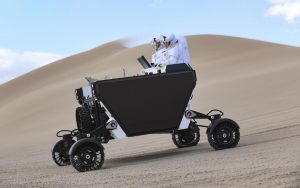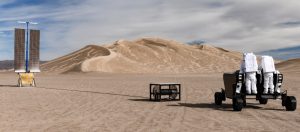Described as an adaptive, multi-use rover that can autonomously swap payloads and mobilize astronauts, the idea is to enable the next generation of lunar and planetary exploration. Specifically, the company foresees demands for a new approach to surface operations given a huge increase in Moon operations.
Rather than landing tens or hundreds of kilograms of payload per decade, it will soon be possible to land hundreds of tons on the Moon each month, says the company. Basically, we’re talking the about the industrialization of the lunar environment.
“As we transition from the Apollo era, which was focused on pure exploration, to now, where people will be living for longer periods on the Moon, the equipment needs to change,” said Chris Hadfield, Astrolab Advisory Board Member. “When we settle somewhere, we don’t just need to get people from one place to another, but we need to move hardware, cargo, life support equipment and more. And it’s all dependent on mobility. It was not only a joy to drive FLEX but also see its size, capability and get an intuitive sense of what this rover can do.”
As it can serve as an unpressurized rover for a crew of two astronauts, its design is in line with NASA’s Lunar Terrain Vehicle (LTV) requirements.
FLEX is more than just a concept, the company maintains. Astrolab has apparently tested a full-scale, fully-functional terrestrial prototype of the FLEX rover in the California desert near Death Valley (pictured). Tests included crewed and telerobotic operations, a deployment of a variety of large payloads, and testing of the rover’s mobility in difficult terrain.
All very impressive, but is it just me that there’s more than a hint of the early-Edwardian motor vehicle about that main image?
Retired NASA and Canadian Space Agency astronaut and engineer Chris Hadfield, quoted above, participated in the five-day field test to give his feedback on the vehicle’s design and performance.
The company writes:
“The FLEX rover’s unique commercial potential comes from its novel mobility system architecture, which gives it the ability to pick up and deposit modular payloads in support of robotic science, exploration, logistics, site survey/preparation, construction, resource utilization, and other activities critical to a sustained presence on the Moon and beyond. Built with adaptive utility in mind, FLEX can also serve as an unpressurized rover for a crew of two astronauts, in line with NASA’s Lunar Terrain Vehicle (LTV) requirements.”
You can see more in the video below:
"gadget" - Google News
April 13, 2022 at 08:59PM
https://ift.tt/W7nsyIU
Gadget In Extremis: Astrolab FLEX rover eyes lunar industrialisation - Electronics Weekly
"gadget" - Google News
https://ift.tt/Sq40sE5
Bagikan Berita Ini


















0 Response to "Gadget In Extremis: Astrolab FLEX rover eyes lunar industrialisation - Electronics Weekly"
Post a Comment